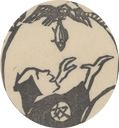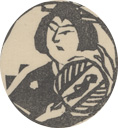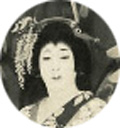About This Print
This print portrays three actors in three dance performances, performed at the Mitsukoshi Theater (三越劇場 Mitsukoshi gekijō) in September 1948. The actors and their roles are as follows: |  | Onoe Shōroku II 尾上松緑 (二代目) (1913-1989) as Tobi no mono [Tobi no mono Matsukichi] 鳶のもの [鳶の者松吉 ] in Sarutori さる酉 (サルトリ) |
 |  | Ichikawa Omezō IV 市川男女蔵(四代目) (1898-1969) as Yatsutaki taira 奴瀧平 in Tonbi Yakko とんび奴(トンビヤッコ) |
 |  | Onoe Baikō VII 尾上梅幸(七代目) (1915-1995) as Benten Oteru 弁天おてる in Karigane 雁がね(カリガネ) [“wild goose”] |
For details of these performances please visit the website "Kabuki on the web" at:
The inscription to the left of the inset on the top right reads 松緑の 鳶のもの (shōroku no Tobi no mono)
The inscription at the top of the bottom right inset reads 弁天おてる 梅幸 (Benten Oteru Baikō)
The inscription beneath the center left inset reads 男女蔵 Omezō and the character on the sleeve of Omezo in the inset reads 奴 Yakko.
1 Details on the performances during the Mitsukoshi Theater 1948 and 1949 kabuki seasons can be found at Kabuki on the Web http://www.kabuki.ne.jp/
Sasajima's Mitsukoshi Theater Prints
I have only seen general references to these small prints depicting various productions during the 1948 and 1949 kabuki seasons at the Mitsukoshi Theater. One reference appearing in Shizuya Fujikake's 1953 print survey book Japanese Wood-Block Prints, simply states "Since 1947, he [Sasajima] is producing a great many Kabuki prints in his unique, black and white style."1 [As can be seen by several of the prints in this collection, Sasajima also used subtle color in some of the prints, hand-applying ink to the print's verso.] Another reference notes that in 1948 (Shōwa 23), at the age of 42, Sasajima "produces Mitsukoshi kabuki prints, but the work affects his health and he suspends the activity after three years."2
1 Japanese Wood-block Prints, Shizuya Fujikake, Japan Travel Bureau, 1953, p. 173-174.
The Mitsukoshi Theater
Source: Tokyo from Edo to Showa 1867-1989 : the Emergence of the World's Greatest City, Edward Seidensticker et al., Tuttle Pub., 2011.
The Mitsukoshi Theater played a significant role in the revival of kabuki after the damage inflicted to the major Tokyo kabuki theaters during WWII. "Ever since its rebuilding after the 1923 earthquake [Great Kantō Earthquake], Mitsukoshi had had an auditorium which it rented out for meetings and performances. The name was changed from Mitsukoshi Hall to Mitsukoshi Theater in 1947, at which time it became a full-fledged, full-time theater. In addition to providing another place for Kabuki, a somewhat more sumptuous and elegant one than the Tōkegi [the only major Kabuki theater to survive the WWII bombing], the Mitsukoshi Theater was very important in passing Kabuki on from an aging generation to an emerging one."
The theater was last used for kabuki in 1951, the year the Kabuki-za opened.
The Actors in the Print
For background on the actors see their respective entries in the article The Kabuki Actor on this site.
Print Details
| IHL Catalog | #1386 |
| Title | Three Dance Performances at the Mitsukoshi Gekijō: Onoe Shōroku II in Sarutori; Ichikawa Omezō IV in Tonbi Yakko; Onoe Baikō VII in Karigane |
| Series | Mitsukoshi Kabuki Hanga 三越歌舞伎版画 [untitled series of prints for the Mitsukoshi Theater 1948 and 1949 kabuki seasons] |
| Artist | Sasajima Kihei (1906-1993) |
| Signature | not signed |
| Seal |  |
| Publication Date | 1948 |
| Publisher | likely Mitsukoshi Gekijō or the artist |
| Carver | self-carved |
| Impression | excellent |
| Colors | excellent |
| Condition | excellent |
| Genre | sosaku hanga; kabuki-ga |
| Miscellaneous | |
| Format | |
| H x W Paper | 8 1/2 x 5 7/16 in. (21.6 x 13.8 cm) |
| H x W Image | 4 3/8 x 3 1/8 in. (11.1 x 7.9 cm) |
| Collections This Print | |
| Reference Literature |


